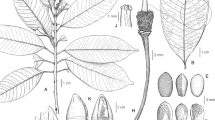Abstract
Chrysophyllum moralesianum and C. sierpense, two new species endemic to Costa Rica, are described and illustrated. Also provided is a dichotomous key for the species of Chrysophyllum that occur in the Osa Peninsula.
Resumen
Se describen e ilustran dos nuevas especies endémicas de Costa Rica, Chrysophyllum moralesianum y C. sierpense. Adicionalmente, se provee una clave dicotómica para las especies de Chrysophyllum presentes en la Península de Osa.





Similar content being viewed by others
Literature cited
Aguilar, R., X. Cornejo, C. V. Bainbridge, M. Tulig & S. A. Mori. 2008 onward. Vascular Plants of the Osa Peninsula, Costa Rica The New York Botanical Garden, Bronx, New York. sweetgum.nybg.org/osa (Accessed January 2015).
Barrantes, G., Q. Jiménez, J. Lobo, T. Maldonado, M. Quesada & R. Quesada. 1999. Evaluación de los planes de manejo forestal autorizados en el período 1997–1999 en la Península de Osa. Cumplimiento de normas técnicas ambientales e impacto sobre el bosque natural. Informe para la Fundación Cecropia. Costa Rica. Pp. 1–96.
Cornejo, X., S. A. Mori, R. Aguilar, H. Stevens & F. Douwes. 2012. Phytogeography of the trees of the Osa Peninsula, Costa Rica. Brittonia 64: 76–101.
Hammel, B. E., M. H. Grayum & R. Aguilar. 2014. Tapirira lepidota (Anacardiaceae), a unique new species from the Golfo Dulce region of Costa Rica. Phytoneuron 2014–10: 1–5.
Kriebel, R., R. Aguilar & F. Almeda. 2008. A new and threatened arborescent Miconia (Melastomataceae: Miconieae) from the Osa Peninsula, Costa Rica. Proceedings of the California Academy of Sciences 59: 489–495.
Morales, J. F. 2012. Nuevas especies de Sapotaceae para Costa Rica. Darwiniana 50: 107–113.
Morales, J. F.. 2015. Sapotaceae. Pp. 96–140. In: B. E. Hammel, M. H. Grayum, C. Herrera & N. Zamora (eds.), Manual de Plantas de Costa Rica. vol. VIII. Sabiaceae–Zygophyllaceae. Monographs in Systematic Botany from the Missouri Botanical Garden 131: 1–657.
Pennington, T. D. 1990. Sapotaceae. Flora Neotropica Monograph 52: 1–771.
Pennington, T. D. 2009. Neotropical Sapotaceae. In: W. Milliken, B. Klitgård & A. Baracat. (2009 onwards), Neotropikey —Interactive key and information resources for flowering plants of the Neotropics. http://www.kew.org/science/tropamerica/neotropikey/families/Sapotaceae.htm. (Accessed 20 November 2015).
Santamaría-Aguilar, D., R. Aguilar & N. Zamora. 2014a. Una especie nueva de Couepia (Chrysobalanaceae) con pétalos pubescentes y endémica de la Península de Osa, Costa Rica. Phytoneuron 64: 1–7.
Santamaría-Aguilar, D., A. Estrada & R. Aguilar. 2014b. Dos nuevas especies de Myrcia del Pacífico Sur de Costa Rica. Journal of the Botanical Research Institute of Texas 8: 449–455.
Swenson, U. & A. A. Anderberg. 2005. Phylogeny, character evolution, and classification of Sapotaceae (Ericales). Cladistics 21: 101–130.
Swenson, U., J. E. Richardson & I. V. Bartish. 2008. Multi-gene phylogeny of the pantropical subfamily Chrysophylloideae (Sapotaceae): evidence of generic polyphyly and extensive morphological homoplasy. Cladistics 24: 1006–1031.
Terra-Araujo, M. H., A. D. de Faria, A. Alves-Araujo & M. Alves. 2013. Pradosia restingae sp. nov. from the Atlantic forest, Brazil. Nordic Journal of Botany 31: 437–441.
Terra-Araujo, M. H., A. D. de Faria, A. Vicentini, S. Nylinder & U. Swenson. 2015. Species tree phylogeny and biogeography of the Neotropical genus Pradosia (Sapotaceae, Chrysophylloideae). Molecular Phylogenetics and Evolution 87: 1–13.
Terra-Araujo, M. H., A. D. de Faria & U. Swenson. 2016. A taxonomic update of Neotropical Pradosia (Sapotaceae, Chrysophylloideae). Systematic Botany 41: 634–650.
Zamora, N. 2013. Una nueva especie de Schnella (Leguminosae, Caesalpinioideae: Cercideae) para Costa Rica. Phytoneuron 12: 1–6.
Zamora, N., B. E. Hammel & M. H. Grayum. 2004. Vegetación/Vegetation. Pp. 91–216. In: B. E. Hammel, M. H. Grayum, C. Herrera, & N. Zamora (eds.), Manual de Plantas de Costa Rica. vol. I. Introducción/Introduction. Monographs in Systematic Botany from the Missouri Botanical Garden 97: 1–299.
Acknowledgments
We thank Chris Davidson, Sharon Cristoph, Finca Playa Karé, and the Blue Moon Foundation for their support of the Vascular Plants of Osa project, and the herbaria A, CR, GH, MO. Also, Mike Grayum for his revision and proofreading of the manuscript, Stephanie Keil and Mike Blomberg for helping on the images, Alex Mauricio Campos for his excellent illustrations, Cristian A. López for checking Panamanian specimens, and Laura Lagomarsino and two anonymous reviewers for comments on the manuscript. José Miguel Chaves-Fallas is funded by the Whitney R. Harris World Ecology Center.
Author information
Authors and Affiliations
Corresponding author
Rights and permissions
About this article
Cite this article
Santamaría-Aguilar, D., Chaves-Fallas, J.M. & Aguilar, R. Two new species of Chrysophyllum (Sapotaceae) endemic to Costa Rica. Brittonia 69, 222–230 (2017). https://doi.org/10.1007/s12228-016-9459-8
Published:
Issue Date:
DOI: https://doi.org/10.1007/s12228-016-9459-8




